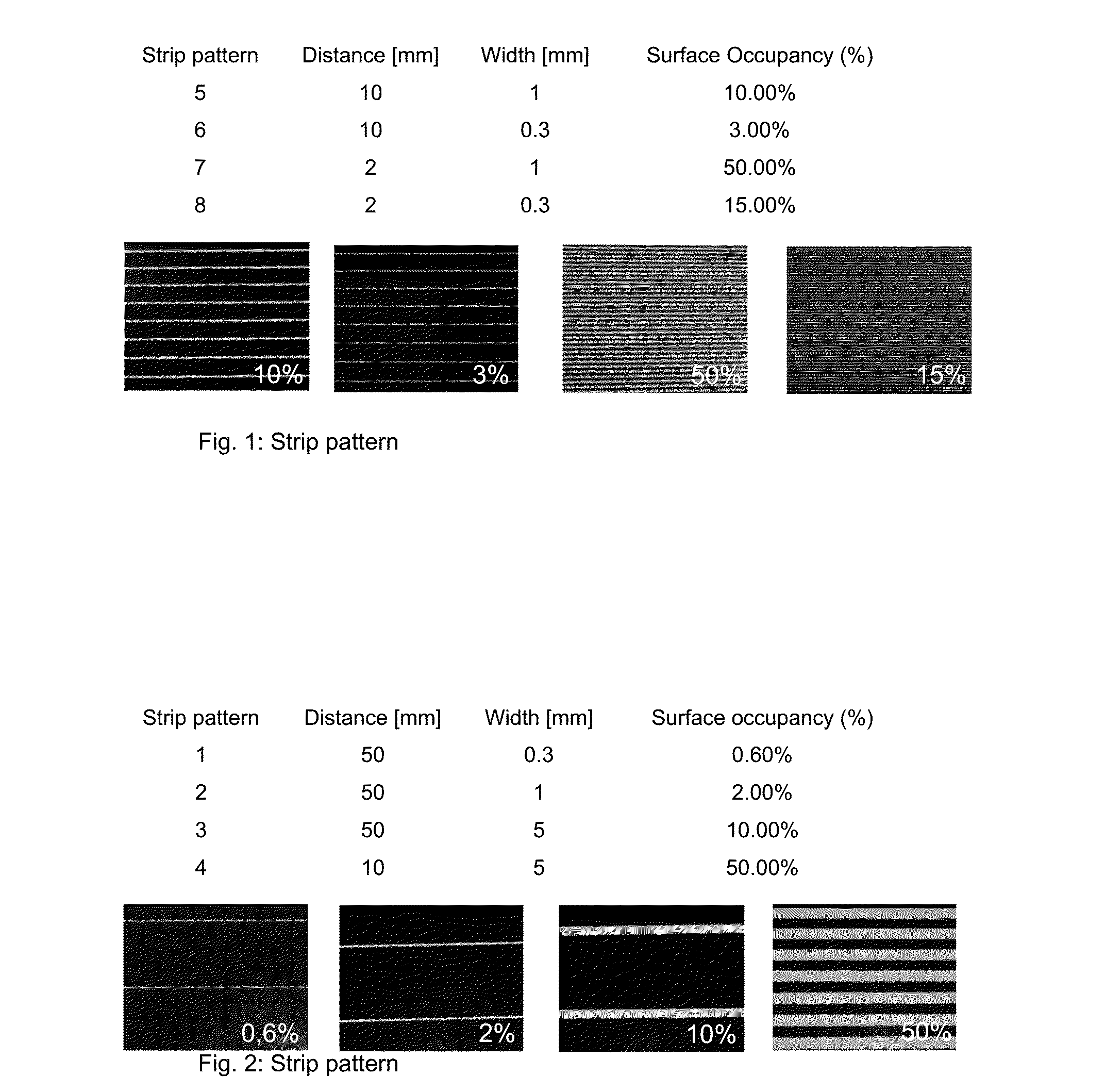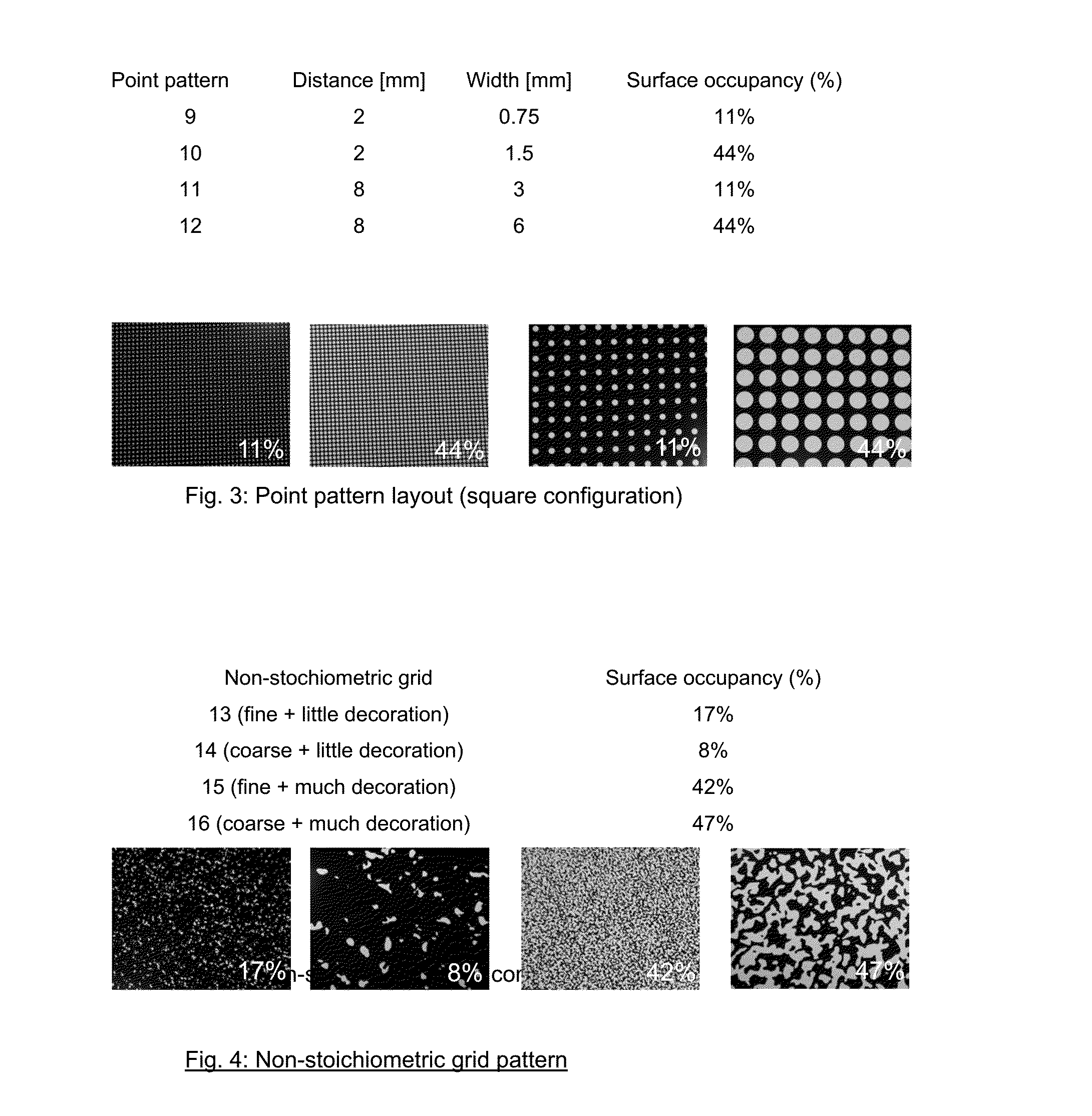Substrate coated with a noise-optimized glass-based coating and method of producing such a coating
a technology of noise-optimized glass and substrate, which is applied in the direction of coating, hot plate heating arrangement, electric/magnetic/electromagnetic heating, etc., can solve the problems of disadvantageous noise reduction of enamel-based decorations on cooktop surfaces
- Summary
- Abstract
- Description
- Claims
- Application Information
AI Technical Summary
Benefits of technology
Problems solved by technology
Method used
Image
Examples
example 1
Color 8
[0127]50 g of glass frit (glass C (specifications in wt.-%: 58% SiO2, 6% Al2O3, 20% B2O3, 6% R2O, 10% RO+RO2; Tg=460° C., Ew=650° C.; with Tg=transition temperature and Ew=softening temperature), particle size D50=1.5 μm, D90=4 μm, agglomerate-free) ground within an attritor (dry) using a sifter were mixed with 60 g of screen printing paste medium, were dispersed and homogenized using a three-roller-mill so that no agglomerates were present. The resulting paste was applied onto a lithium aluminum silicate green glass of 4 mm thickness and transparently colored (140 fabric, full surface decoration on 250×380 mm2). A printed green glass plate was simultaneously burnt-in within the furnace and ceramized (Tmax 935° C., holding time 10 min). The Ra-value of this plate was 0.24 μm; rms10 mm−1 . . . 20 mm−1: 0.096 μm, rms20 mm−1 . . . 50 mm−1: 0.0355 μm; the loudness value was 5.1 sone and the acuteness value 2.8 acum. A different green glass plate which was prepared identically was...
example 2
Color 4
[0128]For preparing color 4 35 G of a glass frit ground using an attritor (dry) with a sifter (glass A, specification in wt.-%: 52% SiO2, 17% Al2O3, 19% B2O3, 4% R2O, 8% RO+RO2, Tg=580° C., Ew=750° C.), grain size D50=1.5 μm, D90=4 μm) were mixed with 65 g screen printing paste medium and 15 g structure-providing of homogenous sphere-shaped methylpolysiloxane particles of a particle size of 4.5 μm. This paste was homogenized using a dispersing machine for 10 minutes. Using a screen of size 140 one layer of the point pattern 11 and 12 of this color was applied by means of screen printing onto green glass (500 mm×550 mm, thickness 4 mm) and was dried at 180° C. for 30 minutes. The firing was performed at about 900° C. simultaneously with the ceramization of the green glass to yield a transparent glass ceramic. This burnt-in decoration was whitish, semi-transparent and matt. The Ra-value was 1.02 μm at both patterns, rms 10 mm−1 . . . 20 mm−1: 0.32 μm, rms 20 mm−1 . . . . 50 mm−...
example 3
Color 6
[0129]50 g of a glass frit (glass A, specifications in wt.-%: 52% SiO2, 17% Al2O3, 19% B2O3, 4% R2O, 8% RO+RO2, Tg=580° C., Ew=750° C.), particle size D50=1.5 μm, D90=4 μm, agglomerate-free) ground within an attritor (dry) using a sifter were mixed with 60 g screen printing paste medium and were homogenized using a three-roller-mill so that no agglomerates were present. The resulting paste was applied by screen printing (140 screen, full surface decoration onto 250×380 mm2 and with a point pattern 11 and 12 onto 500 mm×550 mm) onto an already ceramized, whitish, translucent glass ceramic plate of a thickness of 4 mm and was subsequently burnt-in at 850° C. for 1 hour. The Ra-value of the transparent glaze was 0.07 μm, rms10 mm−1 20 mm−1: 0.018 μm, rms20 mm−1 . . . 50 mm−1: 0.005 μm. The plate with the full surface decoration had a loudness of 2 sone and an acuteness of 2.2 acum. Comparable values of the acuteness were also obtained with the point pattern 11 and 12 (loudness 2...
PUM
| Property | Measurement | Unit |
|---|---|---|
| roughness | aaaaa | aaaaa |
| roughness | aaaaa | aaaaa |
| diameter | aaaaa | aaaaa |
Abstract
Description
Claims
Application Information
 Login to View More
Login to View More - R&D
- Intellectual Property
- Life Sciences
- Materials
- Tech Scout
- Unparalleled Data Quality
- Higher Quality Content
- 60% Fewer Hallucinations
Browse by: Latest US Patents, China's latest patents, Technical Efficacy Thesaurus, Application Domain, Technology Topic, Popular Technical Reports.
© 2025 PatSnap. All rights reserved.Legal|Privacy policy|Modern Slavery Act Transparency Statement|Sitemap|About US| Contact US: help@patsnap.com



